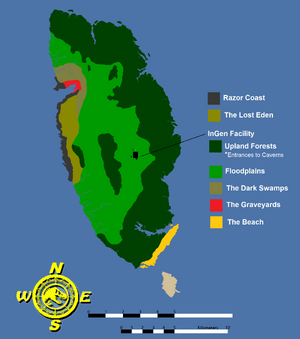
Isla Muerta map by Dinos4Ever of JPL
Isla Muerta is an island inhabited by various different animal species originating from the Cenozoic and Paleozoic epochs. The diversity of fauna is also heightened by marine reptiles from Isla Sorna venturing into its waters.
The island is feared by fishermen, who believe the calls of the island's Gigantopithecus population are of the cries of the unlucky sailors who ventured too close to the island and died from either being attacked by monstrous sea serpents or were killed and sunk by a ghostly force. As such, the island is the basis for the archapelagio's name, The Five Deaths, amongst local fishermen.
The entire Muerta Sea is inhabited by giant prehistoric marine mammals and reptiles, meaning there's plenty of culprits to sink any ship in this forboding ocean. Cruise ships often avoid this archapelagio altogether if they can, though that doesn't stop the animals from venturing from the archepelagio and attacking them anyways.
The island itself, however, is comprised of many biomes:
Floodplains:[]

This is the main area of Isla Muerta, where the prey and predators often interact. The vast grassland is the main hunting grounds for most of the island's predatory animals, such as Smilodon populator, Canis dirus, Dimetrodon grandis, Andrewsarchus mongolinesis and Varanus priscus. It's rich food supply allows for the herbivores, such as Megatherium americanum and Pilohippus pernix, to thrive in the area.
The Razor Coast:[]
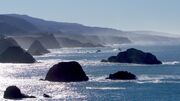
This is where most unlucky "tourists" end up if they aren't killed by the marine fauna beforehand. The coast is home to amphibious fauna such as Nothosaurus mirabilis, Moritherium andrewsi, Enilarctos emlongi and Basilosaurus cetiodes live. As such, it's best to keep on you're toes while drinking, lest you be dragged into the water by a giant whale killer or other marine carnivorous species.
Upland Forests:[]
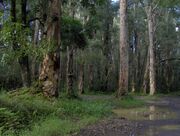
This vast pine and oak forest houses not only the Dire Wolf (Canis dirus), but also the Scimitar-Toothed Cat (Dinofelis paleoona), Diatryma parisensis, Dimetrodon grandis, Varanus prisicus, Thylacoleo carnifex 'amplus', as well as plenty of herbivores. This area is especially dangerous to unfortunate strandees, as the infamous Dropcat and Marsupial Lion, two arboreal-hunting mammals, are common here. In fact, here they are apex predators, using their camofluage and amazing skills to take over the niches of the Dire Wolf and Smilodon. However, Thylacoleo preys upon unwary Dinofelis, and Dinofelis will often prey upon young, sick or old Thylacoleo.
InGen Facility:[]
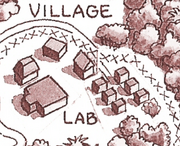
The concrete structures of this abandoned facility, once the area where inGen workers used to clone the animals that currently inhabit the island. Animals that live in the rusted and desolate halls of this facility include Panthera onca gombaszoegensis, Gigantopithecus blackii and Lystrosaurus murrayi.
Muerta Caverns:[]
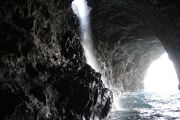
This absolutely massive network of caves connects all of the island, and many species make their homes here, as well as travel here inbetween the areas of the island. Thus, these caverns don't really sport native species, but all the species of Muerta (excluding marine or water-dependant animals such as Titanoboa and Estemmenosuchus.)
Dark Swamps:[]
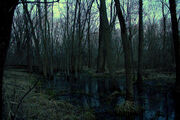
This area is an absolute danger zone for even the mighty Megatherium, as the absolutely titanic constrictor Titanoboa lives here, as well as Quinkana, Deinosuchus, and Gracillosuchus. As well as the native species, Basilosaurus often enter this area during prolonged storms. Other natives include Moetherium, Estemmenosuchus and Ambulocetus.
The Graveyards:[]
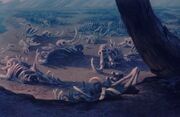
The resting place of all of the animals, this is not inhabited by any sort of animal, aside form the occasional scavengers looking for an easy meal.
The Beach:[]
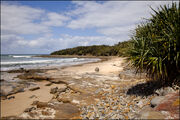
This is the first place you'd see upon landing on the island. This beautiful beach has lured many a sailor to their demise at the jaws, paws or claws of the island's prehistoric inhabitants. Animals like Nothosaurus and turtles nest here, aquatic mammals like Enilarctos shore here or on the Great Rock, and Andrewsarchus can often be seen running up and down the beach, looking for corpses or small prey to eat.